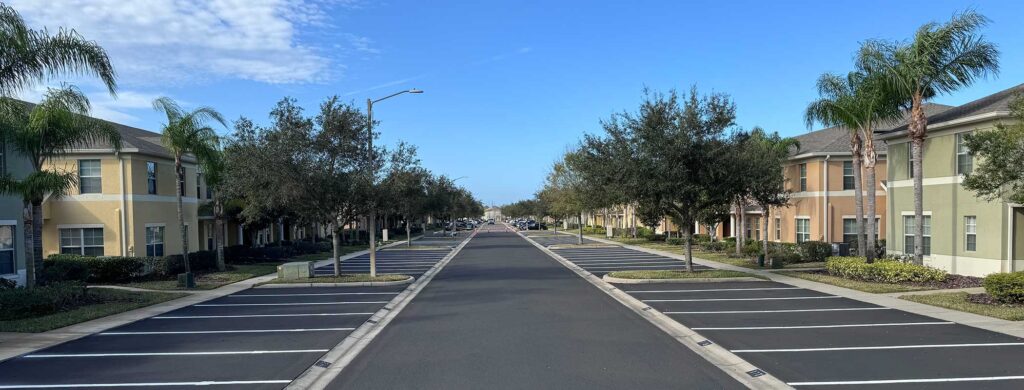Are you considering upgrading your property with new paving solutions but feeling overwhelmed by the plethora of options available? Choosing the right paving solution is crucial not only for aesthetic appeal but also for functionality, durability, and long-term maintenance. To help you navigate through this process smoothly, we’ve compiled 10 essential tips to guide you in selecting the perfect paving solution for your property.
1. Define your objectives and needs.
Before diving into the world of paving solutions, take some time to identify your objectives and needs. Are you looking to enhance curb appeal, create a durable driveway, or design an inviting patio space? Understanding your goals will steer you towards the most suitable paving materials and designs.
Understanding Your Objectives:
- Curb Appeal: If your primary goal is to enhance the aesthetic appeal of your property, you might prioritize materials and designs that add visual interest and complement the overall style of your home or building.
- Durability: For areas with heavy traffic, such as driveways or commercial spaces, durability becomes a key factor. Opting for sturdy materials like concrete or asphalt may be more suitable to withstand constant use and weather elements.
- Functionality: Take into account the paved area’s functionality. What will the area be used for: parking, walking, or recreational purposes? This will help determine the type of paving solution that best suits your needs.
Climate Considerations:
- Weather Conditions: Consider your region’s climate. Certain paving materials may perform better in specific weather conditions. For instance, in areas prone to freezing temperatures, materials that can withstand frost and thaw cycles are preferable.
2. Consider Your Budget
Paving projects’ costs can vary significantly depending on the materials used and the size of the area to be paved. Establish a realistic budget early on to narrow down your options and avoid overspending. Remember to account for not just the initial installation cost but also long-term maintenance expenses.
Factors Influencing Budget:
- Material Costs: Different paving materials come with varying price tags. While options like concrete and asphalt are relatively affordable, natural stone and brick tend to be more expensive. Consider the pros and cons of each material in relation to your budget.
- Installation Expenses: Labor costs for installation can also vary depending on factors such as accessibility, site preparation, and the complexity of the design. Obtain multiple quotes from reputable contractors to ensure competitive pricing.

Long-Term Maintenance:
- Maintenance Cost Consider the long-term maintenance expenses associated with your chosen paving solution. Some materials may require regular sealing, repairs, or cleaning to prolong their lifespan and appearance.
- Lifecycle Costs: While certain materials may have higher upfront costs, they may prove to be more cost-effective in the long run due to their durability and minimal maintenance requirements.
By defining your objectives and setting a realistic budget, you can make informed decisions when choosing the right paving solutions for your property.
3. Assess the climate and environmental factors.
Depending on weather conditions and environmental factors, different paving materials react differently. Consider the climate in your region, including temperature variations, precipitation levels, and soil type. Opt for paving solutions that can withstand the local climate and minimize environmental impact.
Climate Considerations:
- Temperature Variations: Extreme temperature fluctuations can cause certain paving materials to expand and contract, leading to cracks and deterioration over time. Choose materials that are resilient to temperature changes prevalent in your area.
- Precipitation Levels: In regions with high rainfall or snowfall, drainage becomes a critical factor. Select permeable paving solutions that allow water to seep through the surface while preventing pooling, reducing the risk of erosion and water damage.
- Soil Type: The composition and drainage properties of the soil beneath the paved surface can affect its stability and longevity. Conduct soil tests to determine its composition and drainage capacity, and select paving materials that are compatible with the soil type.

4. Explore Various Paving Materials
From traditional options like concrete and asphalt to natural stone, brick, and permeable pavers, there is a wide range of materials available for paving projects. Research the pros and cons of each material, considering factors such as durability, aesthetics, maintenance requirements, and eco-friendliness.
Common Paving Materials:
- Concrete: Versatile and durable, concrete is a popular choice for driveways, walkways, and patios. Users can choose from a wide range of finishes and can stamp, stain, or texture it to enhance its appearance.
- Asphalt: Ideal for high-traffic areas, asphalt provides a smooth and flexible surface that withstands heavy loads and harsh weather conditions. Routine sealing and maintenance are necessary to preserve its integrity.
- Natural Stone: Known for its timeless elegance and durability, natural stone such as granite, limestone, and bluestone adds a luxurious touch to outdoor spaces. Each type of stone offers unique colors, textures, and patterns, but may require periodic sealing and maintenance to prevent staining and erosion.
- Brick: paving, with its classic charm and enduring appeal, creates a warm and inviting atmosphere. It is available in various colors and patterns, offering endless design possibilities. However, bricks may shift over time, requiring occasional repairs and releveling.
- Permeable Pavers: Designed to promote water infiltration and reduce runoff, permeable pavers help mitigate stormwater runoff and replenish groundwater levels. They are ideal for eco-conscious projects and areas prone to flooding or erosion.
5. Evaluate maintenance requirements.
Maintenance is an essential aspect of any paving solution. Some materials may require regular sealing, cleaning, or repairs to ensure longevity and appearance. Assess your willingness and ability to maintain the paving surface over time and choose materials that align with your maintenance preferences.
Maintenance Considerations:
- Sealing Requirements: Certain paving materials, such as concrete and natural stone, may benefit from periodic sealing to protect against moisture penetration, staining, and surface deterioration. When evaluating maintenance requirements, consider the cost and frequency of sealing treatments.
- Cleaning and Stain Removal: Consider the ease of cleaning and stain removal for different paving materials. Porous surfaces like natural stone and brick may be more prone to staining and require specialized cleaning products or techniques to maintain their appearance.
- Repair Needs: Over time, paving surfaces may develop cracks, unevenness, or deterioration due to wear and tear. Evaluate the ease of repair and availability of materials for patching and restoring the surface to its original condition.
6. Prioritize Durability and Longevity
Investing in high-quality, durable paving materials can save you time and money in the long run. Look for materials that can withstand heavy traffic, harsh weather conditions, and other potential sources of wear and tear. Consider the paving solution’s expected lifespan and choose accordingly.
Factors for Durability:
- Strength and Resilience: Paving materials should be resilient to heavy loads, vehicle traffic, and environmental stressors such as freeze-thaw cycles and UV exposure. Choose materials with high compressive strength and resistance to cracking and surface abrasion.
- Weather Resistance: Evaluate the ability of the paving material to withstand the climatic conditions prevalent in your region. Materials like concrete and asphalt are known for their durability in various weather conditions, while natural stone and brick may require additional protection against frost and moisture.
- Longevity: Consider the paving material’s expected lifespan and weigh it against the initial investment. While some materials may have higher upfront costs, they offer superior durability and longevity, reducing the need for frequent replacements and repairs.
By assessing maintenance requirements and prioritizing durability and longevity, you can select paving materials that offer long-term value and performance for your property.
7. Think about design and aesthetics.
Paving solutions play a significant role in shaping the visual appeal of your property. Think about the overall design aesthetic you want to achieve, whether it’s a sleek modern look, a rustic charm, or a timeless elegance. Explore different patterns, textures, and colors to find the perfect fit for your property’s style.
Design Considerations:
- Visual Cohesion: Consider how the paving design integrates with the existing architecture and landscape elements of your property. Aim for visual cohesion and harmony between the paved surfaces and surrounding features, such as buildings, gardens, and outdoor furniture.
- Personal Style: Reflect on your own style preferences and aesthetic sensibilities. Do you prefer clean lines and minimalist designs, or do intricate patterns and textures draw you in? Tailor the paving design to reflect your unique taste and personality.
- Functional Layout: Balance aesthetic considerations with practical functionality. Ensure that the paving layout facilitates smooth traffic flow, provides adequate space for seating or outdoor activities, and enhances the usability of outdoor areas.

8. Seek professional advice and references.
Consulting with experienced paving contractors or landscape designers can provide valuable insights and recommendations tailored to your specific needs. Ask for references and examples of past projects to assess the quality of their workmanship and ensure compatibility with your vision.
Benefits of Professional Advice:
- Expertise and Experience: Paving professionals bring specialized knowledge and expertise to the table, helping you navigate through the myriad of options and make informed decisions. They can recommend suitable materials, designs, and construction techniques based on your preferences and budget.
- Customized Solutions: A professional paving contractor or landscape designer can assess your property’s unique characteristics and requirements to develop customized paving solutions that align with your vision and objectives.
- Quality Assurance: By hiring reputable professionals with a proven track record, you can have confidence in the quality and durability of the final outcome. They adhere to industry best practices and standards to deliver superior results that stand the test of time.
Portfolios and references:
- Some of our reviews are here:
- Client Testimonials: Reach out to past clients to inquire about their experience working with the contractor or designer. Ask about communication, timeliness, professionalism, and satisfaction with the end result.
You can embark on your paving project with confidence, knowing that you have the expertise and support to bring your vision to life by seeking professional advice and references.
9. Develop a Proper Drainage Plan
Effective drainage is essential to prevent water pooling, erosion, and structural damage to your paving surface. Consider incorporating drainage solutions such as sloping, grading, or permeable pavers to channel water away from high-traffic areas and prevent moisture-related issues.Importance of Proper Drainage:
- Preventing Water Damage: Poor drainage can lead to water accumulation on paved surfaces, which can weaken the foundation, cause cracks, and promote the growth of mold and mildew. Proper drainage systems help redirect excess water away from the paved area, reducing the risk of damage and extending its lifespan.
- Erosion Control: Adequate drainage prevents soil erosion and sediment buildup, preserving the integrity of the surrounding landscape and preventing soil erosion-related issues.
- Minimising Slip Hazards: Standing water on paved surfaces can create slippery conditions, posing safety hazards for pedestrians and vehicles. Proper drainage reduces the risk of slips and falls, ensuring a safer environment.
10. Obtain multiple quotes and compare options.
Finally, don’t rush into a decision without exploring multiple quotes and comparing different options. Request detailed estimates from reputable paving contractors, including materials, labor costs, timelines, and warranty information. To make an informed decision, balance cost considerations with quality and reliability.Benefits of Obtaining Multiple Quotes:
- Cost Transparency: Obtaining multiple quotes allows you to gain a clear understanding of the overall cost involved in your paving project. It helps identify any discrepancies or hidden fees and ensures transparency throughout the decision-making process.
- Comparing Options: Each paving contractor may offer different materials, construction techniques, and pricing structures. Comparing quotes enables you to evaluate the pros and cons of each option and select the one that best meets your budget and requirements.
- Assessing Quality and Reputation: Beyond cost considerations, evaluate each paving contractor’s reputation and credentials. Research online reviews, check references, and inquire about past projects to assess their quality of workmanship and customer satisfaction levels.
Considerations for Comparison:
- Materials and Specifications:Each quote should specify the type and quality of materials to be used, along with any additional features or customization options.
- Workmanship and Warranty: Learn about the contractor’s warranty policy and workmanship guarantees. A reputable contractor should stand behind their work and offer assurances against defects or installation issues.
- Project Timeline: Clarify the expected timeline for completion, as well as any potential delays or scheduling constraints that may impact the project.
"*" indicates required fields






